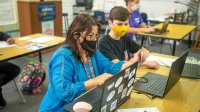Flexible Lesson Planning for World Language Classes
A predictable structure for world language lessons can keep students on track when shifting between distance, hybrid, and in-person learning.
Your content has been saved!
Go to My Saved Content.With the myriad challenges of this year and especially the need to transition from virtual learning to hybrid and in-person classes, I have adapted how I teach content in my Spanish classes in a strategic way by breaking up lessons into five parts to make these transitions easier for both my students and me. Each lesson part, which is paced using a set amount of time, provides multiple ways for learners to engage with the content in meaningful ways.
Lesson Planning for Maximum Flexibility
Warmup: My warmup takes five minutes and is an opportunity for students to get their brains ready for learning middle school Spanish. I usually have five review questions from the previous class. During this quick activity, I open the Zoom classroom and also greet kids at the door of my classroom. All students, regardless of whether they’re learning at home or at school, are engaged and getting ready for the day together.
Students know what is expected of them from the moment class starts, and I use a Google Form where they answer the questions. I’m able to download their responses into a spreadsheet, so this is simple for all of us.
New material: Introduction to new material is the second part of the lesson, a time when I provide direct whole group instruction. This usually takes between 10 and 15 minutes. All students are logged onto Zoom and either hear from me live or watch a video that I have prerecorded with Screencastify. It’s important that all students receive the same instruction with the new material.
They can go back and watch the recorded Zoom or Screencastify videos on our Google Classroom, which has been extremely helpful when students are quarantined or out of school for extended periods. It’s also valuable if they need to review material. And I only have to record each lesson once, instead of doing one prep for in-person students and another for students at home.
Collaborative learning: This is the part of the lesson when I give students opportunities to interact with one another and the material, usually for about 10 minutes. I use Pear Deck Flashcard Factory, Quizlet Live, and Zoom breakout rooms, which serve to replace our in-person station rotation activity. This is great for building community among all students. They get to talk to one another and practice the material with a peer. This has really helped students learning in person and at home stay connected. Zoom breakout rooms are helpful for random grouping, which leads students to interact with different peers throughout the year.
I promote student choice and voice through this time. For example, students can choose to work with me, with a partner, or in groups of five or more. I want students to be able to have choices when they are deciding how they want to work. I allow them to choose their own learning room, which has been beneficial for students who like more intimate settings rather than whole group activities. When we return to person, I will still implement the same kind of centers, where students will be able to choose which area of the room they want to go to. I’ve found this strategy to be beneficial because students have often thrived when they could choose a task rather than being assigned one by me.
Independent work: This is when students work with the material and complete tasks independently to interact with the material on their own for 10 or 15 minutes, rather than with the whole group. I use Quizizz and Google Forms to provide meaningful experiences to learn the material. With these online quizzes, students get immediate feedback on whether they are answering the question correctly, and as the teacher I’m able to download student and whole class data accurately. I can offer feedback on each question, either to each student or larger groups.
Students can also create their own Google Forms—for example, they might create a study guide of questions and answers based on the lesson. This is a great way to show what they know.
Exit ticket reflection: The final part of each lesson is the exit ticket, which takes about five minutes. During this time, students reflect on their learning and answer a series of questions about the daily lesson. They usually record a brief Flipgrid video, and they can use Play-Doh to create something that represents the vocabulary word. This helps students explain what the lesson is all about. For example, if we are studying school vocabulary, they can make a lápiz, or pencil. The Play-Doh helps students explain their thinking out loud. They also reflect on how they feel the lesson went. By gathering these data points, I’m better able to serve the needs of my students and refine my lesson to improve learning outcomes.
Through in-person, virtual, and hybrid teaching, I have learned that it’s important to provide consistency to students and keep routines in place as much as possible. The five aspects of my lessons described here allow students to stay engaged and interact with each other in meaningful ways.
